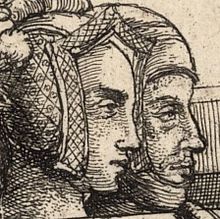You may have read here, here, here or even here about the regular own goals of a certain “Tudor”-ist tr oll.
oll.
Anyway, given the fact that Henry VII, whether Tudor, Beaufort or Swynford, is not descended from Blanche, Duchess of Lancaster in suo jure but from her husband’s mistress and later wife, Katherine de Roet, he wasn’t a true lineal Lancastrian. Carson has listed thirty individuals, some mentioned here, who were alive on 22 August 1485 and were descended from Blanche, therefore having better claims than Henry.
Now duRose mentions that Henry VII was descended from Blanche’s paternal aunt, therefore he was a lineal Lancastrian. This is actually true but very counter-productive. As you can see below, Blanche had no brothers but an elder sister, whose only child died in infancy. Her father, Henry of Grosmont, had no brothers but five sisters, one of whom was a prioress but the other four all had issue and descendants alive in 1485.
You can see quite clearly that Henry’s ancestress was Mary, the youngest of the quintet. Eleanor, the fourth sister, leads to Richard III et al whilst there are three lines to John Howard, Duke of Norfolk and a lot of other famous people are listed.
Here is the evidence that there are now HUNDREDS of people with a better lineal Lancastrian claim than Henry VII in 1485.

Here, here!
LikeLike
The fact that someone is descended from the Lancastrians by a junior line is neither here nor there in the question of succession. One or two people out there (I have met this argument before) seem to think that any drop of Lancastrian blood generations ago is some kind of magic lottery ticket that gives a person a superior claim to the throne. It isn’t, as long as there are senior claims around.
One could very easily make up a long list of obscure descendants of Edmund of Langley (for example) who no one would seriously consider to be Yorkist heirs.
To cut to the chase, after 1471 there is no doubt that Edward IV was both heir male and heir general of Edward III. So however you think the inheritance should descend (by male heirs or through females) Edward IV was the man. And therefore the next heirs were his heirs, however you count them.
LikeLike
In the grand scheme of things, it doesn’t matter. People opposed to Richard for whatever reason latched on to Henry Tudor as the best bet for a ‘Lancastrian’ challenger. There was a battle and he won. That effectively ended other claims as he claimed by conquest. As long as he held on to the crown, all the rest is irrelevant and, much as we may not like it, he did die in his bed and passed the crown to his son.
LikeLike
This post is factually inaccurate. As a rule in England a dukedom could not be passed to a female. Blanche was never Duchess in her own right. On the death of her father, John of Gaunt was created Duke by his father.
So Blanche was Duchess only as the wife of the Duke. John was first Duke in the second creation. The Royal line of Lancaster as representrd by the Lancastrian Kings begins with John.
See the website of the Duchy of Lancaster check out facts for yourself.
LikeLike
“A Dukedom could not be passed to a female”, so Anne Mowbray was actually a boy?
LikeLiked by 1 person
Now that is what you call an own goal!
Anne is an excellent example of the same principle. She nherited the Earldom as Countess on the death of her father.
The Dukedom became extinct and was recreated for her husband. So she became Duchess of York as well, but neither title was in her right.
The present queen is the Duke of Lancaster, but she is not a man.
https://en.m.wikipedia.org/wiki/Richard_of_Shrewsbury,_Duke_of_York
LikeLike
Mr. DuRose’s standard trick is to wait a fair interval after having been debunked, then repeat the same debunked information.
LikeLiked by 1 person
Yes,I have seen it in trolls from other fora on other subjects. 😀
LikeLike
Yes, there could be hundreds of people now who have a better right than Henry had. The question is, how many were there in 1485 – who were not ruled out by being either (a) foreign, (b) female, (c) in the Church, or (d) simply not interested? or any combination of the above?
LikeLike
So if you don’t trust Wikipedia, how about the official website of the Duchy of Lancaster
http://www.duchyoflancaster.co.uk/about-the-duchy/history/
Blanche could not inherit. Why is it so important to ignore this demonstrable fact?
LikeLike
The previous comment sums up my attitude. Any claim back to Blanche rests on the fiction that Edmund “Crouchback” was born to Henry III before Edward “Longshanks”.
Being fiction, the claim is invalid.
LikeLike
Oh, we all know that Edmund was about six years younger than Edward I.
Nevertheless, Henry IV’s propaganda insisted that Edmund was older and that he, as Edmund’s heir through Blanche, was the rightful king.
Furthermore, all senior lineal Lancastrians are descended from Blanche. The rules were not as black and white as today but several titles were “smuggled” through the female line – eg the Earldoms of Warwick (at least twice), Salisbury and Essex – but such that they were only inherited by the heiresses’ children, not those of a different wife. Hence the terms “in suo jure” and “in jure uxoris”.
LikeLike